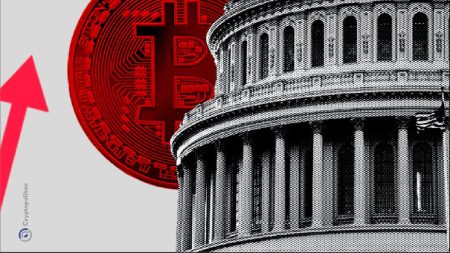The Dawn of a New Bull Market: Bitcoin’s Resurgence
Bitcoin is once again making headlines as it enters a robust new bull market phase, fueled by a combination of institutional investments and the growing popularity of Bitcoin ETFs. Analysts at Bernstein have pinpointed this resurgence, highlighting the emergence of fresh opportunities in both Bitcoin and related equities. The market began its upward trajectory in late 2023, shortly after the U.S. greenlit spot Bitcoin exchange-traded funds (ETFs). This regulatory shift marked a significant turning point, as it not only legitimized Bitcoin as a viable investment option but also opened the floodgates for institutional capital. Following the launch of these ETFs in January 2024, Bitcoin’s price soared from approximately $25,000 to $46,000, signaling a newfound confidence in the cryptocurrency. Bernstein predicts that this growth will continue, driven by a series of positive influences on the horizon.
Institutional Investments and Bitcoin ETFs: The Catalysts for Growth
The influx of institutional investments into Bitcoin ETFs has been a critical driver of Bitcoin’s recent price surge. According to Bernstein, these investments have played a pivotal role in pushing Bitcoin’s value to unprecedented heights, including an all-time high of nearly $109,000 after a period of consolidation. One of the most significant catalysts for this growth has been the pro-crypto stance of former U.S. President Donald Trump, who vowed to establish a national Bitcoin reserve during his presidential campaign. This promise has instilled a sense of optimism among investors, drawing more attention and capital to the cryptocurrency. The proposed creation of a national Bitcoin reserve is another key factor expected to drive Bitcoin’s price movement. Bernstein suggests that the Federal Reserve or the U.S. Treasury could spearhead this initiative by allocating digital assets into their reserves. To finance these acquisitions, the government may consider selling a portion of its gold holdings or issuing debt. Additionally, Bitcoins confiscated from illegal activities could be incorporated into the reserve, further bolstering market confidence.
Regulatory Changes and Institutional Adoption: A Perfect Storm for Growth
The growing interest of institutional investors and the evolving regulatory landscape are other critical factors driving the surge in Bitcoin demand. In recent weeks, several major players have made substantial investments in Bitcoin ETFs, signaling a growing acceptance of cryptocurrency as a legitimate asset class. For instance, the Mubadala Sovereign Wealth Fund has invested over $437 million in Bitcoin ETFs, while heavyweight financial institutions like Goldman Sachs and Barclays are also increasing their exposure to Bitcoin. These moves indicate a broader shift in the financial sector, as more institutions begin to recognize the potential of digital assets. Furthermore, the Securities and Exchange Commission (SEC) has repealed its Staff Accounting Bulletin (SAB) 121, which previously barred banks from holding cryptocurrency. This regulatory change has removed a significant barrier to entry for institutional investors, making it easier for banks and other financial institutions to engage with digital assets. As more institutions enter the market, the demand for Bitcoin is expected to rise, driving prices even higher. Bernstein analysts are confident that Bitcoin’s growth will continue as governments and institutions increasingly invest in the asset.
Bitcoin vs. Gold: The Battle for dominance in Alternative Assets
Bitcoin is increasingly being seen as a rival to gold, as nations and investors begin to consider it as a viable alternative for diversifying their portfolios. Traditional safe-haven assets like gold have long been the go-to choice for investors seeking stability during economic uncertainty. However, Bitcoin’s recent performance and the growing recognition of its potential as a store of value have led some to question whether it could eventually replace or complement gold in this role. Bernstein analyst’s notes that Bitcoin is positioned to capture a portion of the demand typically reserved for gold, as more nations explore the possibility of adding Bitcoin to their reserves. This shift could have significant implications for the global financial system, as it challenges the traditional dominance of gold in the world of alternative assets.
The idea of nations incorporating Bitcoin into their reserves is not as far-fetched as it once seemed. Several countries have already taken steps to diversify their holdings, with some even considering Bitcoin as a hedge against inflation and economic instability. El Salvador, for instance, has been at the forefront of this movement, having adopted Bitcoin as legal tender in 2021. While this decision has been met with skepticism by some, it highlights the growing interest in cryptocurrency as a tool for financial sovereignty and stability. The potential for other nations to follow suit could have a profound impact on Bitcoin’s value, as central banks begin to accumulate the asset in earnest.
The Future of Bitcoin: A Global Reserve Asset in the Making
As Bitcoin’s market value continues to grow, it is increasingly being viewed as a global reserve asset. The combination of institutional adoption, regulatory clarity, and political support is creating a perfect storm of conditions that could propel Bitcoin into the mainstream. The establishment of a national Bitcoin reserve in the U.S., as proposed by Bernstein, could be the catalyst for this transformation. By allocating a portion of its reserves to Bitcoin, the U.S. government would send a powerful signal to other nations, encouraging them to follow suit. This could lead to a wave of central banks around the world adding Bitcoin to their balance sheets, further driving up demand and solidifying its role as a global reserve asset.
In addition to its potential as a reserve asset, Bitcoin’s limited supply and decentralized nature make it an attractive option for investors seeking a hedge against inflation and currency devaluation. As more institutions and nations begin to recognize these benefits, Bitcoin is poised to play an increasingly important role in the global financial system. The growing acceptance of Bitcoin ETFs, coupled with the repeal of restrictive regulations, has removed many of the barriers that once prevented institutional investors from entering the market. With these obstacles now out of the way, the stage is set for Bitcoin to continue its upward trajectory, potentially reaching new highs in the years to come.
In summary, Bitcoin is undergoing a transformative period, driven by a combination of institutional investments, regulatory reforms, and increasing recognition as a viable alternative to traditional assets like gold. As nations and institutions continue to embrace Bitcoin, it is likely to emerge as a key player in the global financial landscape, challenging the dominance of gold and solidifying its position as a major reserve asset. With the support of pro-crypto policies and the growing adoption of Bitcoin ETFs, the future of Bitcoin looks brighter than ever.















